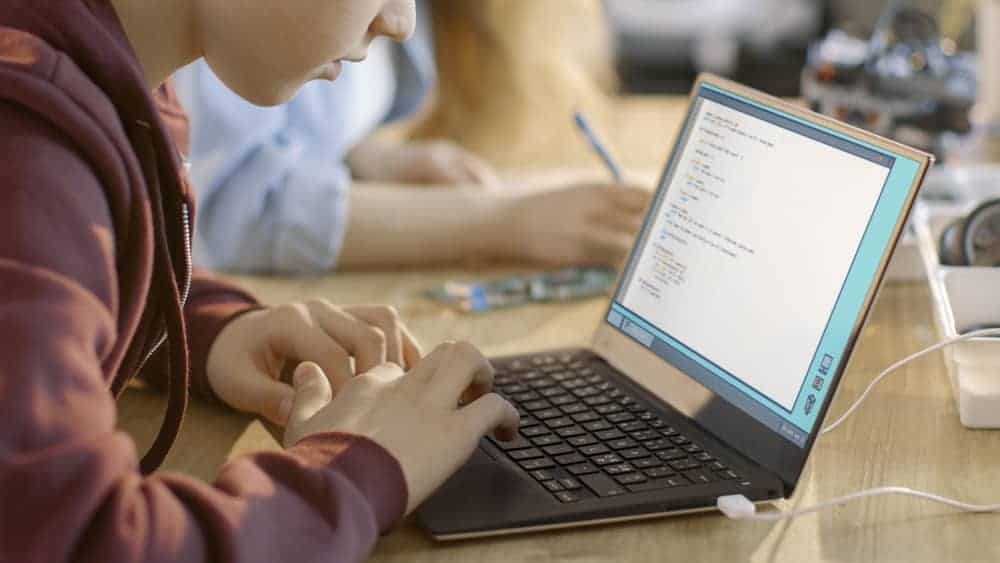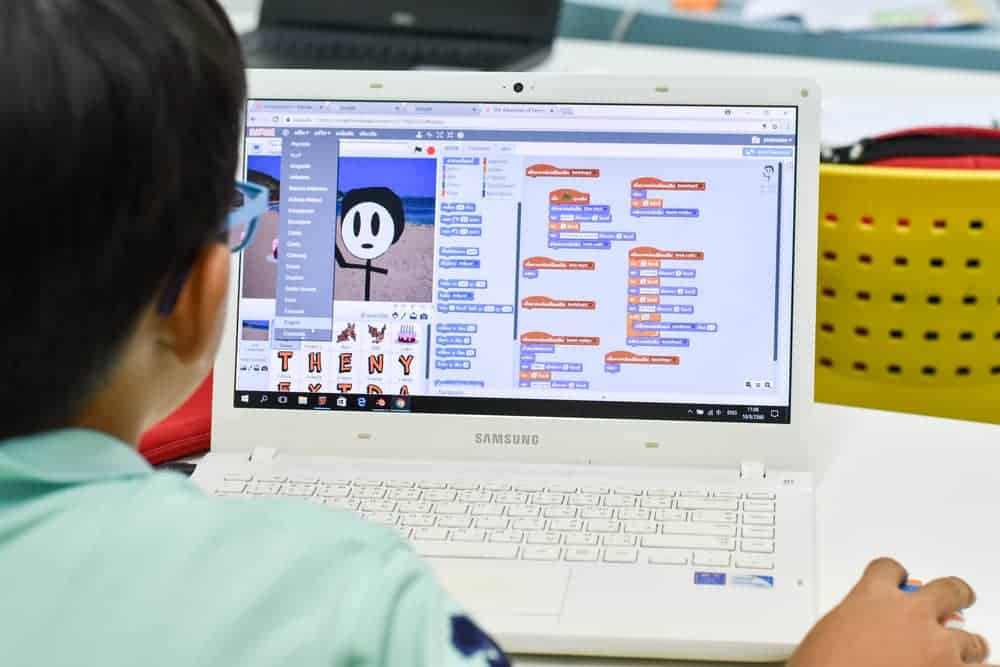
Technology is revolutionizing every aspect of our lives. There’s always some new innovation or development in the world of technology that affects us. Whether it’s a popular video game or new gadget, we hear about it everywhere. So it’s no surprise that children are becoming more and more interested in programming — since it’s the foundation for all the technology we have today.
For kids interested in computers and how they work from a young age, getting introduced to coding can be an excellent way to foster critical thinking. Learning a programming language either through coding classes or self-study can equip them with valuable skills they can use to build video games, computer programs and perhaps use them in their careers one day.
If you have a tech-savvy kid interested in programming, here are some tips on how to choose a programming language for kids and seven of the top options.
Best Programming Languages for Kids
Ten or twenty years ago, coding was for top-tier computer scientists, and there was a reason why — it was bulky and complicated. But today, basic coding languages for kids are simple, and they’re easy for anyone to pick up, even kids.
Once they pick up one, your child can develop their own games, apps, or websites while strengthening their math, problem solving, and critical thinking skills.
There are tons of different programming languages out there, but some are more suitable for children than others.
1. Python
Python is a text-based programming language that’s considered one of the most popular coding languages for kids. It’s an excellent option for beginners due to its focus on white space and simple syntax.
You don’t need a ton of lines of code to get started — just a few lines are all you need to start creating exciting things quickly. It’s known for its use in scientific fields and by major companies like Disney and Google, but this scripting language is versatile enough for kids to use as well.
Python is a fantastic jumping-off point because it can also help them master other languages. You can also create mobile applications, video games, or websites with it. Once they learn Python in-depth, they can create all sorts of applications, online games, or even cybersecurity programs.
There are many extensive Python libraries and resources for online support, so they’ll always have help as they get the hang of it.
2. Scratch
Scratch features a visual programming style that lets kids drag and drop different blocks of code. It’s one of the free educational coding languages explicitly made to help early coders ages 8-16.
It’s a language that teaches them to understand the concept intuitively and builds solid foundation. There’s no typing needed, and it’s a simple, interactive process that taps into a child’s freedom of expression.
Scratch is one of the top kid’s coding languages because it’s simple enough and effective at teaching coding concepts. More than that, it has a large support community that consists of brilliant computer science instructors and enthusiasts. Brilliant minds share their games and code so young kids can see how other advanced programmers use it to create more complex builds.

There’s a lot of room to build and create whatever your child wants to with Scratch. They can create a simple program, totally custom game with animations, interactive stories, and art in just a matter of minutes.
3. JavaScript
Just about everything runs on Javascript these days. All browsers, including Internet Explorer, Chrome, and Mozilla Firefox, use JavaScript. It’s probably better as a second learned language after either Scratch or Python because it does require a higher level of skill, usually suitable for kids ten or older looking for a deeper understanding of coding.
It’s also the single-most used coding language out there for web development. Mastering JavaScript can open up a whole world of opportunities, including learning how to turn the simplest web documents into incredibly interactive web pages, games or apps.
If your child is already familiar with text-based coding, learning JavaScript can broaden their capabilities. The most common use of JavaScript is for interactive web apps, like web-based video games and responsive websites.
4. Lua
Lua is the simplest of text-based coding languages for kids. It helps them create powerful, imaginative games. Lua can be the perfect introduction to this style of programming. It’s elegant, beginner-friendly, portable, and extremely powerful language, with the capability of creating super smooth products.
Lua is a multi-paradigm language, which means it has general features that can apply when solving many common problems. Lua has a pretty short learning curve and is a great language for anyone interested in gaming — it’s the most widely used option for game engines.
The number of users that use Lua is also steadily climbing. It’s beneficial for a child to learn from a young age to get ahead of the curve. It can also help them in their future career, as many big tech companies like Word of Warcraft and Adobe Photoshop use Lua.
Kids who know Lua can use it to create 3D game worlds, like those of their favorite video games.
5. Java
Java is one of the oldest and most widely used coding languages in the world. It’s a great beginner-friendly programming language since it teaches important coding concepts and programming principles like object-oriented programming, inheritance, abstraction, and much more.
It’s utilized by 90% of all Fortune 500 companies, making it perfect for job opportunities and career prospects. It’s also what the popular video game Minecraft is built with. If your child shows an interest in computer science, learning Java is an excellent skill to know. It will make them more marketable and in-demand.
It takes longer to master than most other kids coding languages. However, Java apps are more stable and scalable, opening up the possibilities of what they can create with this procedural programming language.
Kids who learn Java can build game engines, large backend environments, Android mobile apps, graphical programs, or text-based applications.
6. C++
C++ is well-known for its speed and efficiency. Although it’s a complex language that requires a great deal of time and effort to learn, it’s an excellent option for teens who have a baseline knowledge of coding. If they want to dive in deeper to create games, system software, and other software programs, they will need to know C++. It’s also most popularly used in robotics.
If your teen wants to become a computer programmer someday, they should take the time to learn C++. Proficiency is usually an essential resume requirement for programmers. This is especially helpful for any kids who want to go into the gaming industry in particular — due to C++’s popularity in the industry.
With a working knowledge of C++, your teenager can make their very own 2D computer games, develop robust programs, and make different console applications.
7. C#
If you use any third-party apps made for Windows, it’s almost certain that it uses the C# framework created by Microsoft. It’s powerful enough that it can create almost anything. C# is similar to Java, which means it’s easy for someone with prior Java knowledge to pick it up.
Any pre-teen or teen who sees themselves working in this field later on will be doing themselves a favor if they start learning it now. C++ is a great way to develop professional-quality programs, perfect for a young coder who wants to elevate their knowledge of code.
Once they have the hang of the C# language, they can run with it to create all kinds of things. This includes software like web apps, web frameworks, video games, and much more, making it one of the best programming languages for kids.
How To Choose A Programming Language
When selecting the right one for your child, you don’t want to make the decision blindly. A suitable decision should consider their age and skill level, as well as the practicality and accessibility of the language.
Choose Based On Practicality
Apart from simply asking yourself which coding language is easy to learn for kids, also consider practicality. You don’t want to teach them one thing just for them to move onto something else after.
The goal should be functional — what can they build or create with this language? How practical is it that they’ll continue using this language in the future? Pick a language that lends itself well to what your kid wants to build.
Are they into 3D games? Lua would be a great option, as it focuses on video games and is popular among some of the biggest gaming companies out there.
Do they want to work for Microsoft one day? Learning C# would be to their advantage, as it’s the primary language used for Windows apps.
Let the choice factor in who they are, where their interests lie, and how they see themselves using these skills in the future.
Choose Based On Age
You also want to consider how old your child is. Some languages are more complex than others, like C++, C#, and Java.
If they’re young, try something like Scratch or Lua to start them off. These languages can teach them the fundamentals of coding without a steep learning curve to get them warmed up and familiar before diving into more complicated languages.
Teenagers who are intermediate coders and already familiar with computer programming at a basic level would do better with the more complicated languages. They’ll be able to use these skills a few years down the line as they begin their careers.
Choose Based On Skill Level
Just because someone is older doesn’t necessarily mean they’re ready to take on more difficult languages with a bigger learning curve. You also need to consider their skillset.
Are they technologically savvy, or is this their first time interacting with computers beyond the user level? Have they been making games with Scratch for years, now looking to up-level their skills by learning something a bit more complex?
Their skill level should directly influence which language you choose.
Consider Accessibility
If the language looks intimidating and has a high learning curve, you might want to rethink introducing it as a first language. It should be accessible to them and taught in a way that breaks down the complex concepts before throwing them in the ring.
Much of this will depend on not only the language itself but also the coding camp, coding class/course, or teaching program you choose to get them started with. Similarly, a coding language can sometimes run on one or more operating systems, so keep that in mind too.
There are tons of options out there, but some may be more appropriate for your child than others. Some are for games — and some come more easily to beginners. Others are complicated text-based languages better left for the somewhat knowledgeable teenage coder.
Understanding these languages will help you make the right decision, but knowing your child, their interests, and how they want to use their coding skills will help you make the right decision.

Leave a comment